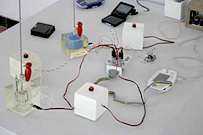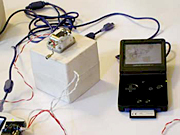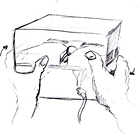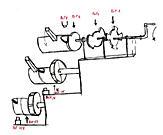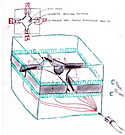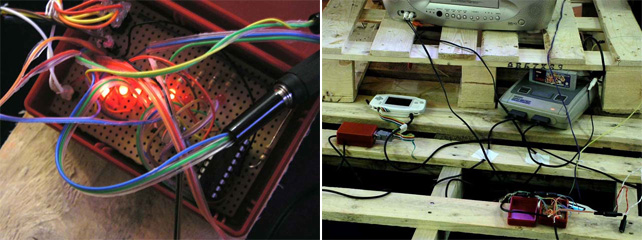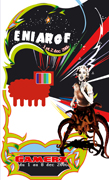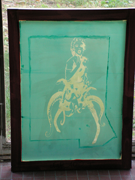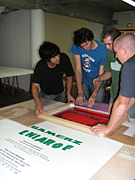More just-in-time-for-ENIAROF portraits to give you an idea about who is behind this project, what sort of things we’re interested in, as well as a glimpse of some of the work produced at the Atelier Hypermedia. This time we’re featuring Antonin Fourneau: inventor and organizer of ENIAROF, researcher at the Atelier de Recherches Interactives (ENSAD), and hacker/artist/coder working in the field of video games.
Here is one of my favorite works of Antonin, which he developped in collaboration with Erational for the FAN project at Villette Numérique 2004:
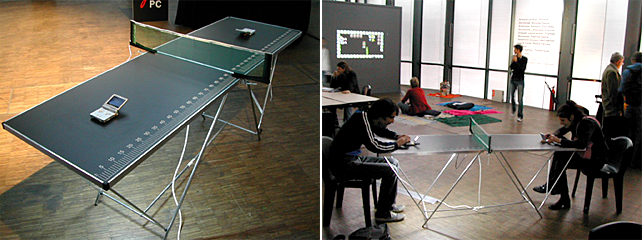
It’s a mini foldout Ping Pong table with two Gameboy Advance consoles connected to each other via a local network (cf. GameboyPong). The ball is then sent back and forth across its « net » via the digital network connecting the two consoles. This fed into Téléférique’s concept of FAN, which created an actual/virtual mix somewhere between « PC Tuning » (cf. JackyPC), Origami, and networking.

Some aspects of this work grew out of two workshops at the school: PLAY+MOBILE and a workshop with Chris Csikszentmihalyi at the Laboratoire L.O.E.I.L.. He then evolved all of these experiments into two projects which he presented for his diploma in 2005: ENIAROF, an innovative alternative to digital arts festivals (i.e. Villette Numérique); and The Gameboy Nucleus:
Here is a YouTube video, or you can click here for Quicktime format: GBA Nucleus #1, GBA Nucleus #2:
The Gameboy Nucleus explores many of the issues we’re interested in at the Atelier, and is basically a physical externalization of the interior structure of the Gameboy. Each of the components you see here (Music Box, Woodpecker Toy, Button, …) are externalized forms of internal registers in the Gameboy. By connecting them up you activate or change the state of these internal registers, and thereby affect the internal algorithm. Although I have been speaking in my writings and workshops for many years about the spatialization of algorithms and the externalization of code, I never actually thought of it in such concrete terms. It really is fascinating to see how he designed it. I also find the drawings just as interesting as the actual working forms: it’s interesting to see how he created physical forms of counters (« i++ »), loops (« for(;;) »), randoms (« rand()% »), and so on. It’s quite lovely to hold code in your hands like that.
Here is a photo of one another work from about the same period, one of his contributions to ENIAROF, the Pince Vocale (scream to get an origami robot out of the onscreen « factory » game and into your hands):
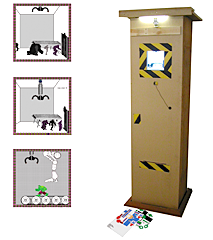
Since September 2005, Antonin has been at ARI in Paris, where he has been expanding this work into a whole series of game console manipulations, some of which he presented at the Tokyo Dorkbot in late September:
One of these works, the Noisy Nucleus was also featured as one of the installations at this year’s Festival Emergences (note: as mentioned previously here, ENIAROF was given « carte blanche » at the festival this year, as a sort of bar-room entertainment between musical acts; a role we were — for once in our lives — happy to fill, given the nature of the project). The central idea to the Noisy Nucleus is that the output of one video game or console (joystick, video output, sound, etc) can be used as input into another video game. He basically hacks into the protocol of various game peripherals (SNES, etc), and creates a transcoder/recorder, allowing signals of one machine to pass into another. For example, while playing streetfighter you can also be mixing a breakcore soundtrack
Click the above images for this Quicktime video clip taken from Antonin’s presentation at ARI.
Finally, for this year’s Arborescence, he and Jankenpopp built a series of ENIAROF-style video game consoles. Two of Antonin’s proposals are worth mentioning. The first is a street-fighter with only one joystick: you basically fight against yourself. In the second, the « jump » button has been connected to the video output of Donkey Kong: whenever you jump the screen goes black; and since you have to jump a lot in Donkey Kong, this makes the game very hard to play:
Here’s a YouTube clip of the modified Street Fighter:
And then finally, comes this year’s ENIAROF, which Antonin is frantically preparing as we speak:
I will mention this later on the blog as we get closer, but if you happen to be at the Chicago Art Institute at the end of the week, Antonin and I will be giving a webcast presentation on the last wednesday of this month (11:00 am). This is part of our cross-atlantic teaching collaboration. We’ll see if we can record that somehow and put it onto some podcast (haven’t gotten around to making one yet).

